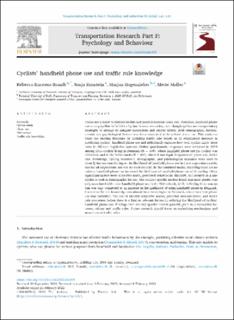| dc.contributor.author | Brandt, Rebecca Karstens | |
| dc.contributor.author | Haustein, Sonja | |
| dc.contributor.author | Hagenzieker, Marjan Paula | |
| dc.contributor.author | Møller, Mette | |
| dc.date.accessioned | 2023-06-19T08:28:39Z | |
| dc.date.available | 2023-06-19T08:28:39Z | |
| dc.date.created | 2022-04-28T12:55:33Z | |
| dc.date.issued | 2022-02-25 | |
| dc.identifier.citation | Transportation Research Part F: Traffic Psychology and Behaviour. 2022, 86 121-130. | en_US |
| dc.identifier.issn | 1369-8478 | |
| dc.identifier.uri | https://hdl.handle.net/11250/3071991 | |
| dc.description | Rebecca Karstens Brandt, Sonja Haustein, Marjan Hagenzieker, Mette Møller, Cyclists’ handheld phone use and traffic rule knowledge, Transportation Research Part F: Traffic Psychology and Behaviour, Volume 86, 2022, Pages 121-130, ISSN 1369-8478, https://doi.org/10.1016/j.trf.2022.02.004 (https://www.sciencedirect.com/science/article/pii/S1369847822000225) | en_US |
| dc.description.abstract | Phone use is likely to distract cyclists and possibly increase crash risk. Therefore, handheld phone use among cyclists is forbidden by law in some countries, even though cyclists use compensatory strategies to attempt to mitigate distractions and related effects. Both demographic, environmental, and psychological factors have been associated with cyclists’ phone use. This study extends the existing literature by including traffic rule beliefs as an explanatory measure in predicting cyclists’ handheld phone use and additionally explores how well cyclists know these rules in different legislative contexts. Online questionnaire responses were collected in 2019 among 1055 cyclists living in Denmark (N = 568), where handheld phone use for cyclists was forbidden, and in the Netherlands (N = 487), where it was legal. Responses on phone use, traffic rule knowledge, cycling behaviour, demographic, and psychological measures were used to identify factors contributing to the likelihood of handheld phone use in three regression models; one for all respondents and one for each country. In the combined model, believing there are no rules on handheld phone use increased the likelihood of handheld phone use while cycling. Other significant factors were subjective norm, perceived behavioural difficulty, self-identity as a safe cyclist as well as demographic factors. The country-specific models found that male gender was only associated with more handheld phone use in the Netherlands, while believing there was no ban was only connected to an increase in the likelihood of using handheld phone in Denmark. Correct traffic rule knowledge was almost three times higher in Denmark, where handheld phone use was forbidden. The results identify subjective norms, potential overconfidence, and traffic rule awareness (when there is a ban) as relevant factors in reducing the likelihood of cyclists’ handheld phone use. Findings from country-specific models possibly point to a connection between culture and traffic rules. Future research should focus on underlying mechanisms and awareness of traffic rules. | en_US |
| dc.language.iso | eng | en_US |
| dc.publisher | Elsevier | en_US |
| dc.rights | Navngivelse 4.0 Internasjonal | * |
| dc.rights.uri | http://creativecommons.org/licenses/by/4.0/deed.no | * |
| dc.subject | Cyclist safety | en_US |
| dc.subject | Phone use | en_US |
| dc.subject | Distractions | en_US |
| dc.subject | Traffic rule knowledge | en_US |
| dc.title | Cyclists’ handheld phone use and traffic rule knowledge | en_US |
| dc.title.alternative | Cyclists’ handheld phone use and traffic rule knowledge | en_US |
| dc.type | Journal article | en_US |
| dc.type | Peer reviewed | en_US |
| dc.rights.holder | © 2022 The Authors. Published by Elsevier Ltd. | en_US |
| dc.description.version | publishedVersion | en_US |
| cristin.ispublished | true | |
| cristin.fulltext | original | |
| cristin.qualitycode | 1 | |
| dc.identifier.doi | 10.1016/j.trf.2022.02.004 | |
| dc.identifier.cristin | 2019802 | |
| dc.source.journal | Transportation Research Part F: Traffic Psychology and Behaviour | en_US |
| dc.source.volume | 86 | en_US |
| dc.source.issue | April 2022 | en_US |
| dc.source.pagenumber | 121-130 | en_US |

